key AUDI A5 COUPE 2010 Workshop Manual
[x] Cancel search | Manufacturer: AUDI, Model Year: 2010, Model line: A5 COUPE, Model: AUDI A5 COUPE 2010Pages: 360, PDF Size: 84.39 MB
Page 266 of 360
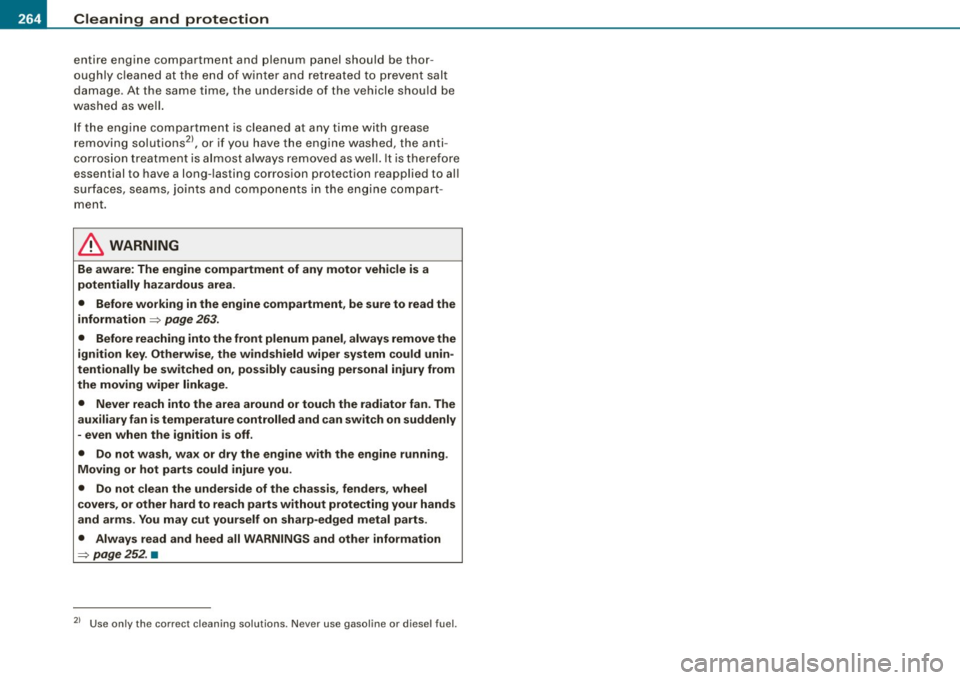
___ C_ le_ a _ n_i_n ~g _ a_ n_ d __ p_r _o _t _e _c_ t_ i_o _n ___________________________________________ _
entire engine compartment and plenum panel should be thor
oughly cleaned at t he end of winter and retreated to prevent sal t
damage . At the same time, the underside of the vehicle shou ld be
washed as we ll.
If the eng ine compartment is cleaned at any t ime with grease
removing solutions
2 l, or if you have the engine washed, the anti
corrosion treat ment is al most a lways removed as wel l. It is there fore
essential to hav e a long- las ting corrosion protection r eapplied to al l
sur faces, sea ms, joints a nd co mponents in the engine compar t
ment.
& WARNING
Be awa re: The engine compartment of any motor vehi cle is a
potentially hazardou s area.
• Before working in the engine compartment , be sure to read the
information
::::> page 26 3.
• Before reaching into the front p lenum panel, always remove the
ignition key . Otherwise , the w ind shield wiper sy stem cou ld unin
tentionally be sw itched on, pos sibly causing personal in jury from
the moving wiper linkage .
• Never reach into the area around or touch the radiator fan . The
a uxil iary f an i s temperature controlled and can switch on suddenly
- even when the ignition is off.
• Do not wash , wa x or dry the eng ine with the e ngine running .
Moving or hot part s could injure you .
• Do not clean the underside of the chassis , fenders , wheel
c overs , or other hard to reach parts without protecting your hands
a nd arms . You may cut yourself on sharp-edged met al parts .
• Always read and heed all WARNINGS and other informat ion
=> page 2 52 . •
21 Us e on ly th e correct c lean ing solut ions. N ev er use gasolin e or di esel fuel.
Page 271 of 360
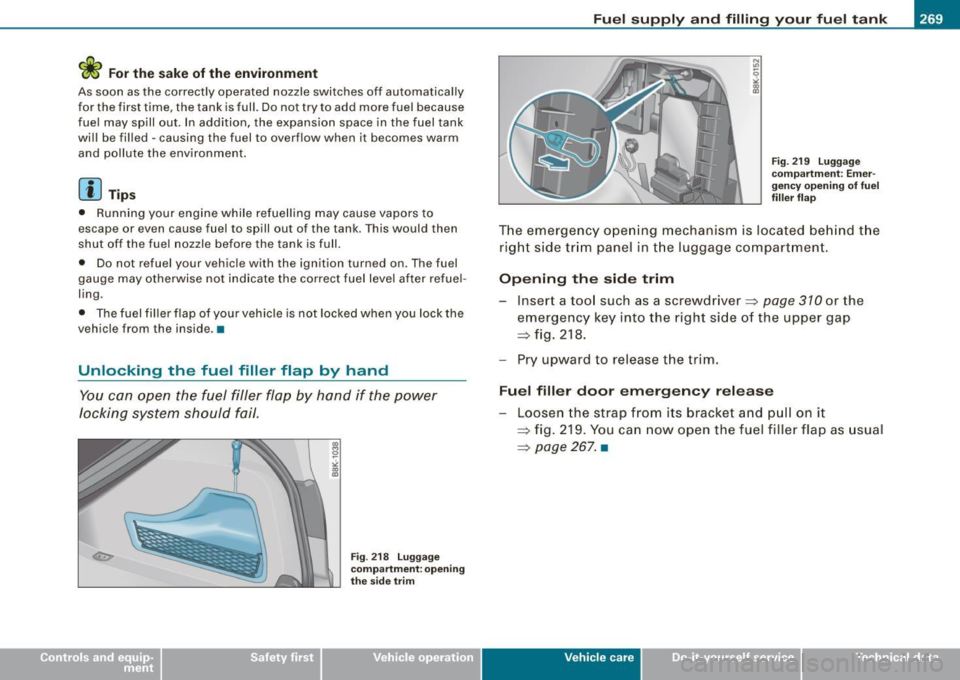
<£> For the sake of the environment
As soon as the correctly operated nozzle switches off automatically
for the first time, the tank is full. Do not try to add more fuel because
fuel may spill out. In addition, the expansion space in the fuel tank
will be filled -causing the fuel to overflow when it becomes warm
and pollute the environment.
[ i] Tips
• Running your engine while refuelling may cause vapors to
escape or even cause fuel to spill out of the tank. This would then
shut off the fuel nozzle before the tank is full.
• Do not refuel your vehicle with the ignition turned on. The fuel
gauge may otherwise not indicate the correct fuel level after refuel
ling .
• The fuel filler flap of your vehicle is not locked when you lock the
vehicle from the inside .•
Unlocking the fuel filler flap by hand
You can open the fuel filler flap by hand if the power
locking system should fail.
Fig . 218 Luggage
compartment : opening
the side trim
Fuel supply and filling your fuel tank
Fig. 219 Luggage
compartment: Emer
gency opening of fuel
filler flap
The emergency opening mechanism is located behind the
right side trim panel in the luggage compartment.
Opening the side trim
- Insert a tool such as a screwdriver=:>
page 310 or the
emergency key into the right side of the upper gap
=:> fig. 218.
- Pry upward to release the trim.
Fuel filler door emergency release
- Loosen the strap from its bracket and pull on it
=:> fig. 219. You can now open the fuel filler flap as usual
=:> page 267. •
Vehic le care I I irechnical data
Page 273 of 360
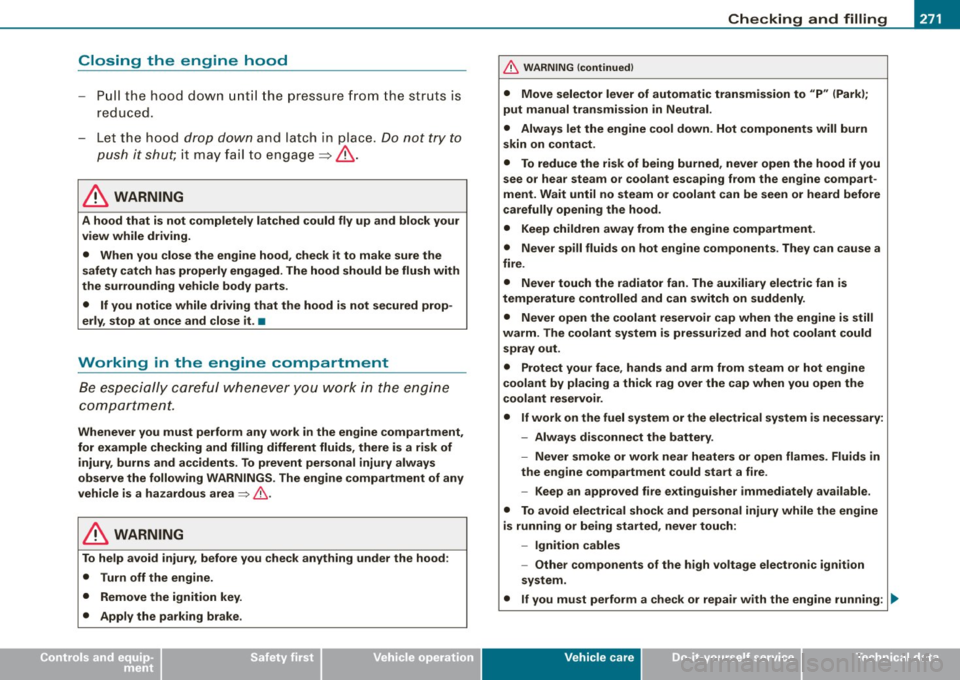
Checking and filling IJI
--------------~-
•
Closing the engine hood
-Pull the hood down until the pressure from the struts is
reduced .
- Let the hood
drop down and latch in place. Do not try to
push it shut;
it may fail to engage => &.
& WARNING
A hood that is not completely latched could fly up and block your
view while driving.
• When you close the engine hood, check it to make sure the
safety catch has properly engaged. The hood should be flush with
the surrounding vehicle body parts.
• If you notice while driving that the hood is not secured prop
erly, stop at once and close it. •
Working in the engine compartment
Be especially careful whenever you work in the engine
compartment.
Whenever you must perform any work in the engine compartment,
for example checking and filling different fluids, there is a risk of injury, burns and accidents. To prevent personal injury always
observe the following WARNINGS. The engine compartment of any
vehicle is a hazardous area
~ & .
& WARNING
To help avoid injury, before you check anything under the hood :
• Turn off the engine.
• Remove the ignition key.
• Apply the parking brake .
& WARNING (continued)
• Move selector lever of automatic transmission to "P" (Park);
put manual transmission in Neutral .
• Always let the engine cool down. Hot components will burn
skin on contact.
• To reduce the risk of being burned, never open the hood if you
see or hear steam or coolant escaping from the engine compart
ment. Wait until no steam or coolant can be seen or heard before
carefully opening the hood .
• Keep children away from the engine compartment.
• Never spill fluids on hot engine components . They can cause a
fire.
• Never touch the radiator fan. The auxiliary electric fan is
temperature controlled and can switch on suddenly.
• Never open the coolant reservoir cap when the engine is still
warm. The coolant system is pressurized and hot coolant could
spray out.
• Protect your face, hands and arm from steam or hot engine
coolant by placing a thick rag over the cap when you open the
coolant reservoir.
• If work on the fuel system or the electrical system is necessary:
- Always disconnect the battery.
- Never smoke or work near heaters or open flames. Fluids in
the engine compartment could start a fire .
- Keep an approved fire extinguisher immediately available.
• To avoid electrical shock and personal injury while the engine
is running or being started, never touch :
- Ignition cables
- Other components of the high voltage electronic ignition
system.
• If you must perform a check or repair with the engine running: ..,
Vehicle care
I t •
Page 284 of 360

-~_C_ h_e _c _ k_ i_n ...:::g::;...._ a_n_ d_ f_ i_ll _in -'g:::;.._ ___________________________________________ _
Have the battery checked when you take your vehicle in for service.
You are well advised to replace a battery that is older than 5 years.
With certain types of airbag deployment, the battery is discon nected from the vehicle electrical system for safety reasons=>
& in
"Repair, care and disposal of the airbags" on
page 202.
Disconnecting the battery terminals
Some vehicle functions (power window regulators, for example) are
lost if the battery terminals are disconnected. These functions have
to be relearned after the battery terminals are connected again . To
prevent this, the battery should only be disconnected from the
vehic le electr ical system when absolute ly necessary for repairs .
Vehicles not driven for long periods
If you do not drive your vehicle over a period of several days or
weeks, electrical components are gradually cut back or switched off.
This reduces energy consumption and maintains starting capability
over a longer period=>
page 241.
Take into consideration that when you unlock your vehicle, some
convenience functions, such as the master key remote function or power seat adjustment, may not be available. The convenience
functions will be available again when you turn on the ignition and start the engine .
Winter operation
During the winter months, battery capacity tends to decrease as
temperatures drop . This is because more power is also consumed
while starting, and the headlights, rear window defogger, etc., are
used more often.
Avoid unnecessary power consumption, particularly in city traffic or
when traveling only short distances . Let your authorized Audi dea ler
check the capacity of the vehicle battery before winter sets in
=>
page 284 . A well charged battery will not only prevent starting
problems when the weather is cold, but will also last longer.
[ i ] Tips
If your vehicle is left standing for several weeks at extremely low
temperatures, the vehicle battery should be removed and stored
where it will not freeze. This will prevent it from being damaged and
having to be replaced. •
Working on the battery
Be especially careful when working on or near the battery.
The battery is located in the luggage compartment under
the floor. Before you check anything in the luggage
compartment,
read and heed all WARNINGS =:>& .
Always heed the safety warnings, when working on the vehicle
battery or the vehicle electrical system to prevent injury.
The following WARNINGS are very important when
working on the battery:
Always heed the following WARNING SYMBOLS and safety pre
cautions when working on the battery.
Always wear eye protection .
Battery acid contains sulfuric acid. Always wear
gloves and eye protection.
Page 311 of 360

__________________________________________________ T_ ir_e _ s_ a_ n _ d_ w_ h_ e_ e_ls _ ____. 1'111
• To ensure a proper TPMS function use AUDI Original Tires which
are marked with "AO" or "RO" on the tire sidewall. =:>
page 299.
• The tire pressure monitoring system on your Audi was calibrated
using tires with the "AO" or "RO" identification. We recommend
using these tires.•
Applies 10 vehicles: with tire pressure monitor ing sys tem
Reset tire pressure monitoring system
If the tire pressure is adjusted, wheels are rotated or
changed, the TPMS must be reset via radio or MM/ *.
-Turn on the ignition.
Fig . 236 Car: Tire pres
sure monitoring
system
Select: the I CAR I function key> Tire pressure monitoring
> Store now.
[ i] Tips
Before resetting the TPMS, the current pressures of all four tires
must correspond to the specified values. Adjust the tire pressure
and reset the pressure in the tire pressure monitoring system
according to the load you are carrying =:>
page 291 . •
Vehic le care I I irechnical data
Page 336 of 360

ffl,__ __ G_e_ n_e_ ra_ l_i_n _f _o _ r_ m_ a_ t_io _ n __________________________________________________ _
General information
Explanation of technical data
Some of the technical data listed in this manual requires
further explanation.
The technical data for your vehicle is listed in the charts starting on
~ page 337. This section provides general information, notes and
restrictions which apply to this data. •
Vehicle identification
The key data is given on the vehicle identification number
(VIN) plate and the vehicle data sticker.
Fig. 259 Vehicle Identi
fication Number (VIN)
plate: location on
driver's side dash
panel Fig
. 260 The vehicle
identification label -
inside the luggage
compartment
The Vehicle Identification Number (VIN)
is located on the driver's side so that it is visible from the outside
through the windshield~ fig. 259.
The vehicle identification label
is located in the luggage compartment near the battery .
The label ~ fig. 260 shows the following vehicle data:
© Production control No.
0 Vehicle identification No.
© Type code number
© Type designation/engine output in Kilowatts
© Engine and transmission code letter
© Paint No./lnterior
0 Optional equipment No.'s
Vehicle data 2 to 7 are also found in your Warranty
& Maintenance
booklet .
The safety compliance sticker
is your assurance that your new vehicle complies with all applicable
Federal Motor Vehicle Safety Standards which were in effect at the
time the vehicle was manufactured. You can find this sticker on the ._
Page 343 of 360
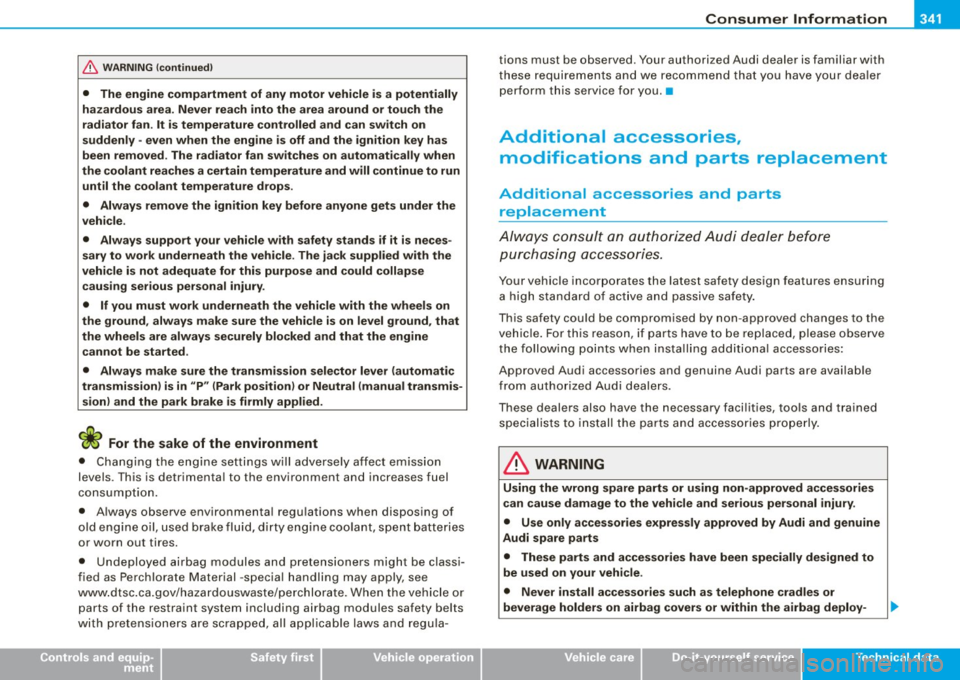
__________________________________________________ C_o_ n _ s_u_ m_ e ___ r_l_ n _f_ o_ r _m...:....:.. a:.;..:. ti .... o:.. n ........ _lllllll
& WA RNIN G (continu ed )
• The engine compartment of any motor vehi cle i s a potentially
h az ardou s area. N ev er re ach into the are a arou nd or to uch the
r a di ator fan . It is temperature co ntrolled and can swi tc h o n
s uddenly -even wh en the engine i s off and the ignition key h as
been removed . The r adiator f an switches on autom atic all y w hen
the coolant reache s a certain temperature and will continue to run
until the coo lant t emper ature drop s.
• Alway s remov e th e ignition key befo re anyone get s under the
v ehi cle .
• Alway s s upport your vehi cle with safety sta nd s if it i s ne ces
sa ry to wor k unde rne ath the veh icle . The ja ck suppl ied with the
v ehic le i s not adequ ate for thi s purpo se and could coll ap se
c au sin g s eriou s per son al in jury .
• If you m ust w ork under neath the vehi cle with the wheel s on
the ground , alwa ys m ake sure the veh icle i s on l eve l ground , that
the wheels ar e always securely blocked and that the engine
ca nn ot be sta rted .
• Alway s mak e sure the tran sm iss ion selecto r leve r (automatic
tr ansmi ssion ) is in "P " (Park po sition ) or Neutr al (manu al tr ansmi s
s ion ) and th e park br ake i s firmly applied.
c£> For the sake of the environment
• Changing the engine settings w ill adverse ly affect emission
levels . This is detrimenta l to the environment and increases fuel
consumption.
• Always observe environmenta l regu lations when disposing of
old engine oil, used brake fluid, dirty engine coolant, spent batteries
or worn out tires.
• Undeployed airbag modules and pretens ioners might be classi
fied as Perchlorate Material -specia l handling may apply, see
www .dtsc .ca .gov/hazardouswaste/perchlorate. When the vehicle or
parts of the restraint system including airbag modules safety belts
with pretens ioners are scrapped, all applicable laws and regu la-
Controls and equip
ment Safety first Vehicle operation
tions must be observed. Your authorized Audi dealer is familiar with
these requirements and we rec
ommend that you have your dea ler
perform this service for you .•
Additional accessories ,
modifications and parts replacement
Addition al a ccessori es and parts
replacement
Always c onsul t an authorized Audi dealer before
purchasing accessories.
Your vehicle incorporates the latest safety design features ensuring a high standard of act ive and passive safe ty .
This safety could be compromised by non -approved changes to the
vehic le . F or this reason, if par ts have to be replaced, please observe
the following points when insta lling additiona l accessories:
Approved Audi accessories and genuine Audi parts are avai lable
from authorized Audi dealers.
These dealers also have the necessary facilities, tools and trained specialis ts to install the parts and accessories prope rly.
& WARNING
Using the wrong spare part s or u sing non-approved acce ssorie s
c an cause d am age to the vehi cle and seriou s pe rsonal injur y.
• Use onl y acc essorie s ex pres sly approved by Audi and g enuine
Audi spare p art s
• The se p art s and acce ssorie s have been spe cia lly de signed to
be used on you r vehi cle .
• Nev er in stall acc ess orie s s uch a s telep hone cra d le s or
be ver age holder s on airb ag cover s or within th e airbag deploy-
Vehicle care Do-it-yourself service Tec hn ica l da ta
Page 344 of 360
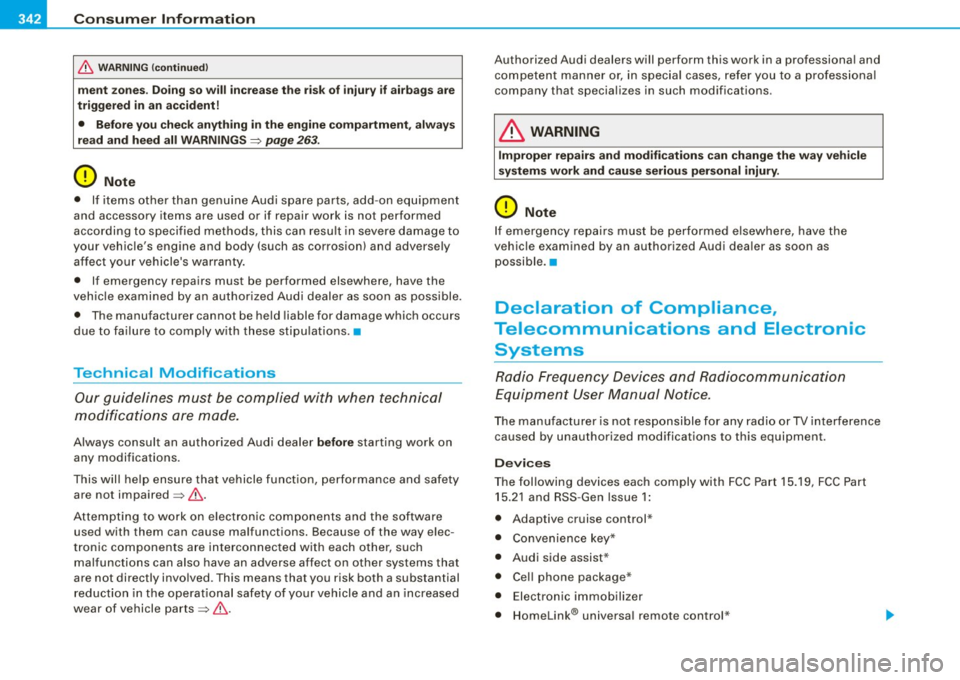
___ C_ o_n_ s_ u_m _ e_ r_ ln_ f_ o _r _m _ a_ t_ i_o _n ______________________________________________ _
& WARNING (con tinued)
men t zo nes. Doin g s o w ill in cre ase the r isk of injury if airb ags are
t rigg ered in an accid en t!
• Before you che ck anything i n the e ngine co m partment , always
re ad and heed all WARN IN GS
~ page 263.
0 Note
• If items other than genuine Audi spare par ts, add-on equipment
and accessory items are used or if repair work is not performed
according to specified methods, this can resu lt in severe damage to
your vehicle 's engine and body (such as corrosion) and adverse ly
affect your vehicle's warranty .
• If emergency repairs must be performed elsewhere, have the
vehic le examined by an authorized Audi dealer as soon as possible.
• The manufacturer cannot be held liable for damage which occurs
due to fai lure to comply w ith these stipu lations. •
Technical Modifications
Our guidelines must be c omplied with when technical
modifi cations are made.
Always consult an authorized Audi dealer before starting work on
any modifications.
This will he lp ensure that vehicle function, performance and safety
are not impaired ~& .
Attempting to work on e lectronic components and the software
used with them can cause malfunctions. Because of the way e lec
tronic components are interconnected with each other, such
malfunctions can also have an adverse affect on other systems that
are not directly involved . This means that you risk both a substantial
reduction in the operational safety of your vehicle and an increased
wear of vehicle parts~& . Authori
zed Audi dealers will perform this work in a professiona l and
competent manner o r, in special cases, refer you to a professiona l
company that specializes in such modifications .
& WARNING
Improper r epair s and m odifica tion s can ch ange th e way veh ic le
syst ems w ork and cau se seri ous per sonal inju ry .
0 Note
If emergency repairs must be performed elsewhere, have the
vehicle examined by an authorized Audi dea ler as soon as
possible. •
Declaration of Compliance,
Telecommunications and Electronic
Systems
Radio Frequency Devices and Radiocommunication
Equipment User Manual Notice.
The manufacturer is not responsible for any radio or TV interference
caused by unauthorized modifications to this equipment.
D ev ices
The fol lowing devices each comply with FCC Part 15.19, FCC Part
15.21 and RSS -Gen Issue 1:
• Adaptive cruise control*
• Convenience key*
• Audi side assist*
• Cell phone package*
• Electronic immobilizer
• Homelink ® universal remote control *
Page 345 of 360
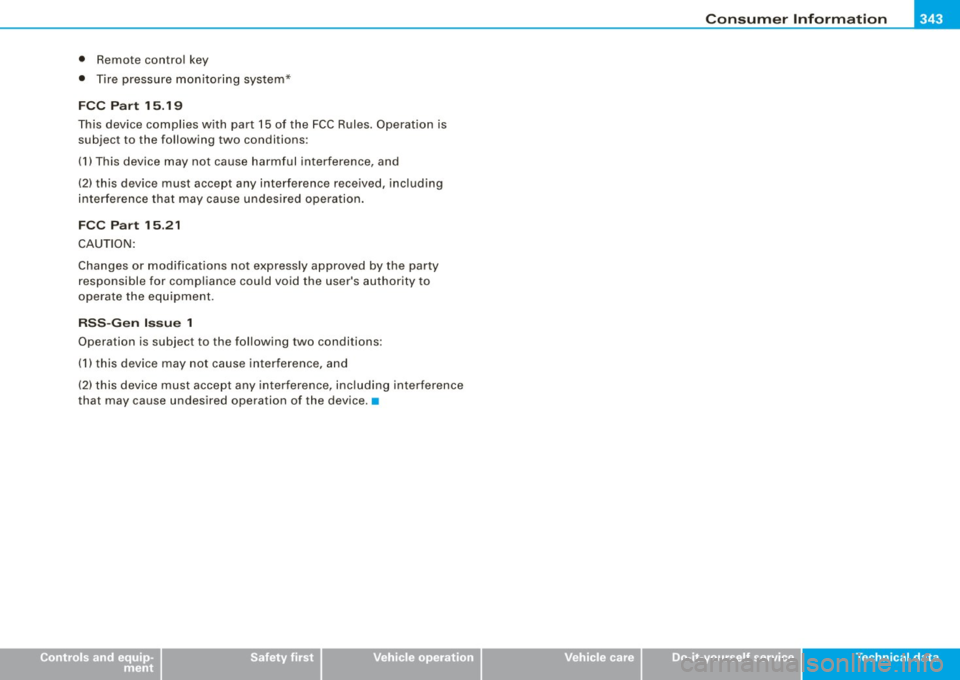
_______________________________________________ C _o_ n _ s_u _ m_ e_ r_l_n _f_o _ r_ m_ a_ t _i _o _ n __ lllll
• Remote control key
• Tire pressure monitoring system*
FCC Part 1 5.1 9
This device complies with part 15 of the FCC Rules. Operation is
subject to the following two conditions:
(1) This device may not cause harmful interference, and
(2) this device must accept any interference received, including
interference that may cause undesired operation .
FCC Part 1 5.21
CAUTION:
Changes or modifications not expressly approved by the party
responsible for compliance could void the user's authority to
operate the equipment.
RSS-Gen Issue 1
Operation is subject to the following two conditions:
(1) this device may not cause interference, and
(2) this device must accept any interference, including interference
that may cause undesired operation of the device. •
Controls and equip
ment Safety first Vehicle operation
Vehicle care Do-it-yourself service Tec hn ica l da ta
Page 348 of 360

llffl __ A_l.:. p _h_ a_ b_e _t _ic _ a_l _in _ d_e _x ____________________________________________ _
Care of exterior ... .. ... ... ... ... ... . 252
Cargo area
See Loading the luggage compartment ..
175
Cargo net .... .... ................... 79
Catalytic converter . . . . . . . . . . . . . . . . . . 244
Center armrest Adjusting ........................ 78
Storage compartment ........ .... . 78
Certification . . . . . . . . . . . . . . . . . . . . . . . 342
Changing a flat tire .. .... .... ....... 312
Changing a wheel ................... 312
Changing engine oi l ...... .... .... ... 276
Chassis Undercoating . . . . . . . . . . . . . . . . . . . . 258
Checking Engine coolant level .. ...... ...... 278
Checking tire pressure .... .... .... ... 293
Child restraint system anchors ........ 227
Child restraints Danger of using child restraints in the
front seat . . . . . . . . . . . . . . . . . . . . . . 190
Where can I get additional information
about child restraints and their use? ...
232
Child safety ................... .... . 213
Convertible locking retractor . . . . . . . 223
Important safety instructions for using
child safety seats .... .... ... .... 216
Important things to know when driving with chi ldren ................... 213
Installing a child restraint using the
LATCH system .................. 229 Lower
anchorages ... ...... ...... . 228
Mounting and releasing the anchorage hook .. .............. ....... ... 229
Tether anchors .. ...... .... .... .. 230
Tether straps ........ ....... ..... 230
Child safety seats ... ........... ..... 218
Booster seats .. ... .... ........ ... 221
Convertible chi ld seats ............ 219
Convertible locking retractor . ...... 223
Danger of using child restraints in the
front seat . . . . . . . . . . . . . . . . . . . . . . 190
How do I properly install a child safety
seat in my vehicle? ........ ...... 216
Infant seats ...... ........ ....... 218
Installing ....................... 223
LATCH system . . . . . . . . . . . . . . . . . . . 229
Safety instructions .... ...... ..... 216
Cigarette lighter ........ ....... ...... 87
Cleaning Alcantara® (synthetic suede) . ..... 262
Engine compartment ....... ... ... 263
Fabrics and fabric coverings ..... .. 259
Instrument panel ................. 260
Interior .. .... .... ... .. .... .... .. 259
Leather ......................... 261
MMI display ..................... 259
MM I termina l .. ... .... .... .... ... 259
Plastic and vinyl .. .. ......... ... . 256
Plastic parts . . . . . . . . . . . . . . . . . . . . . 260
Safety be lts ...... ....... ........ 263
Trim strips . ........... .... ...... 255
trim strips ... .. ........ .... ... ... 256
Cleaning and protection .. ........ ... 252
Clock ........ .... ...... ....... ...... 10 Coat hooks
. . . . . . . . . . . . . . . . . . . . . . . . . . 89
Co ld tire inflation pressure .... ....... 291
Compact spare tire .................. 311
See also Spare tire ........ ...... .. 311
Compass mirror . ...... .. .... .... .... 67
Comp liance ...... .... ....... .... ... 342
Consumer Information .... ... ... . 177, 339
Contacting NHTSA ... .... .... .... ... 177
Convenience closed ... ....... ........ 49
Convenience key ..................... 44
START ENGINE STOP button ... 110, 111
Starting engine .... ....... .... ... 110
Switching engine off .............. 111
Switching on ignition ............. 11
O
Unlocking and locking vehicle ... ... . 44
Convenience opening ...... ........... 49
Convertible child safety seats ...... ... 219
Convertible locking retractor Activating .. ....... .... ...... .... 225
Deactivating ..................... 226
Using to secure a child safety seat .. 223,
225
Coolant system ..................... 277
Cooling System Expansion tank .... ........... ... 278
Cornering light ...................... 57
Cruise contro l
Changing speed . ...... .... .... .. 116
Preselect speed .. ...... ..... .. ... 116
Switching off ... .. .... .... .... ... 116
Switching on ...... ........... ... 115
Warning/indicator lights ... .. ...... . 15
Cruising range ................... .... 23